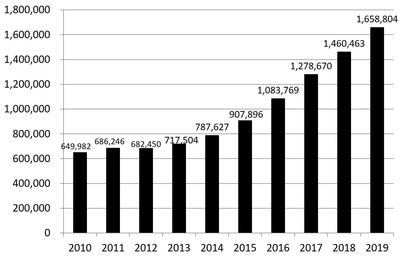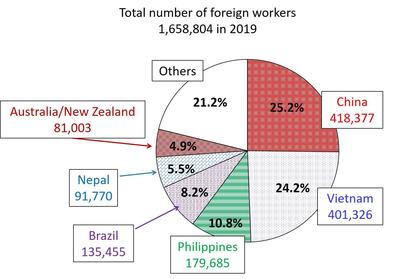Column Finance and the Social Security System 2020.06.30
【Aging, safety net and fiscal crisis in Japan】No.240: Foreign workers
Japan needs to accept foreign workers to deal with the shrinking workforce. Although the government restricted foreigners from entering the country following the spread of COVID-19, they announced that foreign workers would gradually begin to be accepted as the declaration of emergency is lifted.
The number of foreign workers increased 2.5 times from 649,982 in 2010 to 1,658,804 in 2019 (Figure 1). The Ministry of Health, Labour and Welfare prepares statistics by classifying foreign workers into five categories ; resident based on individual status, technical training, non-qualification activities, professional/technical fields, and others (Figure 2). Resident based on individual status includes those with permanent resident status, spouses of permanent residents, and those with a resident visa. Technical training concerns people who have come to Japan to acquire skills. Non-qualification activities are cases where international students are working. Professional/technical fields are highly skilled people such as professors, medical doctors, artists, religious workers, and lawyers. Figure 3 shows the nationality of foreign workers, where China and Vietnam account for 25.2% and 24.2%, respectively.
Figure 1 Number of foreign workers
 *Please click the table image to find the original size image.
*Please click the table image to find the original size image. Source: Ministry of Health, Labour and Welfare
Figure 2 Types of foreign workers
 *Please click the table image to find the original size image.
*Please click the table image to find the original size image. Source: Ministry of Health, Labour and Welfare
Figure 3 Nationality of foreign workers
 *Please click the table image to find the original size image.
*Please click the table image to find the original size image. Source: Ministry of Health, Labour and Welfare
